2. 江西省水土保持科学研究院,南昌 330029
土壤侵蚀会导致土壤严重退化,恶化水土资源,破坏生态环境,是长期困扰全球生态发展的首要问题之一,而该现象在很大程度上归因于不良的耕作方法、毁林、道路和水坝建设[1-2],南方红壤区是中国仅次于黄土高原的严重水土流失区[3]。植物可以通过截留雨滴、增强土壤水分入渗以及增加土壤有机物质来降低土壤侵蚀率[4],因此植被恢复是改善土壤质量和控制土壤侵蚀的有效途径,而土壤水稳性团聚体可以敏感地反映生态系统过程以及植被恢复过程中土壤抵抗侵蚀的能力[5],稳定的土壤团聚体可帮助土壤具有更好的抗剥落和侵蚀的能力[6]。植被对团聚体稳定性的影响主要包括植被地表覆盖、凋落物的生成、土壤有机质和真菌菌丝等结合剂以及发达的地下根系等[7-8]。
不同的植被覆盖下土壤团聚体稳定性具有不同的表现。已有研究表明,植物种类对土壤团聚体稳定性有显著影响[9-10],Caravaca等[11]研究指出农地土壤团聚体稳定性显著小于林地土壤,Zeng等[9]研究也表明不同降雨条件下林地土壤的团聚体稳定性均高于草地和林草地,而An等[12]在同一地区的研究则具有相反的结论,说明同一地区植被恢复对土壤稳定性的研究具有较大差异,还需考虑其他影响因素。植物多样性、禾本科和豆科植物的存在,均会通过植物多样性、土壤有机质、土壤微生物生物量和蚯蚓生物量的变化而显著影响土壤团聚体的稳定性[13]。目前相关研究对象集中于自然条件下演替的植物群落,而关于人工种植下的植被恢复与团聚体稳定性的研究还较缺乏。
目前测定土壤团聚体稳定性的方法主要包括Yoder的湿筛法和Le Bissonnais(LB)法,LB法涉及土壤团聚体分解的几种机制(消散作用、机械扰动和差异性黏粒膨胀),其3种试验包括快速湿润(FW)、预湿润后扰动(WS)和慢速湿润(SW),分别代表了不同的降雨条件(暴雨、外力扰动和温和降雨)。LB法中包含了湿筛法的基本原理,可准确且全面地从团聚体崩解机理方面对土壤团聚体稳定性进行区别评价并且提供更多具体的信息,可很好地适用于南方红壤区,便于了解植被类型对土壤团聚体的影响[9, 14]。因此,本研究使用LB法对4种南方红壤丘陵区常用生态恢复和水土保持植被的土壤团聚体进行研究,探讨了在不同植被覆盖和不同的破坏机制下的土壤团聚体稳定性差异,对理解区域内土壤生态功能的演变具有重要意义,有助于生态环境恢复与保护。
1 材料与方法 1.1 研究区概况研究区位于湖北省武汉市东南部(114°21′47″E,30°28′24″N),区域属亚热带季风气候,年平均气温16.3℃,年平均降水量为1 210 mm,降雨主要集中于春季和夏季(3月至8月),占全年降雨量70%。试验区由于施工导致表层土壤剥离,土壤结构遭到破坏,植被覆盖差,因此选择种植4种中国南方红壤区常用生态恢复和水土保持植物进行植被恢复试验,包括马尼拉(Zoysia matrella)和香根草(Vetiveria zizanioides)2种禾本科草本,以及多花木蓝(Indigofera amblyantha)和紫穗槐(Amorpha fruticosa)2种豆科灌木(表 1)。马尼拉主要分布于热带、亚热带地区,分蘖能力强,草层覆盖度高,抗干旱、耐践踏;香根草抗逆性强、适应性广、速生快长、生物量大、根系发达,具有优良的力学特性;多花木蓝少分枝,适应性强,根系发达,支根须根多,具有良好的水土保持功能;紫穗槐枝叶茂密,侧根发达,耐寒性强、耐干旱能力强,具有防风固沙能力。试验区内土壤为第四纪红色黏土发育的老成土(美国土壤系统分类)。
|
|
表 1 试验点植被覆盖状况 Table 1 Vegetation coverage of the sampling sites |
2012年3月,在研究区内建立16个面积为20 m2(4 m×5 m)的种植区域,随机区组分为4组,每种植被重复种植于4个小区内,小区相互间隔1 m,中间沟道深约20 cm。用沟耕机将16个小区的土壤翻耕至20~30 cm深度,然后在表层土壤中均匀种植了马尼拉、香根草和多花木蓝的种子以及紫穗槐的幼苗。第一年期间对16个小区使用相同的灌溉及除草管理措施,之后植被自然生长。
1.2 样品采集在2017年10月,调查植被覆盖状况(表 1),使用全称重法测定地上生物量,目估法测定覆盖度。之后在每个小区中随机选择3个面积1 m2(1 m×1 m)区域,清除地表覆盖后,使用铝盒在每个区域内采集0~10 cm、10~20 cm和20~30 cm三个土层的原状土,将土样带回实验室风干后,过10目筛子用于测定土壤机械组成,过5目和3目筛子获得3~5 mm团聚体用于测定团聚体稳定性,过100目筛子用于测定土壤有机质含量;同时使用容积100 cm3(直径5 cm,高5 cm)的环刀取土样测定土壤容重;容积500 cm3(直径10 cm,高6.37 cm)的环刀取土样测定根系性状,每层取样均设置两个重复。
1.3 土壤理化性质及团聚体测定使用重铬酸钾外加热法测定土壤有机质;吸管法测定土壤机械组成(根据美国土壤质地分类制,黏粒,< 0.002 mm;粉粒,0.002~0.05 mm;砂粒,0.05~2 mm);环刀法测定土壤容重;LB法[15]测定土壤团聚体稳定性,试验前,将干筛获得的3~5 mm团聚体放在40℃烘箱内烘干24 h至恒重备用。该方法包括三个试验:(1)快速湿润(Fast Wetting,FW):将5 g团聚体迅速浸没于去离子水中,10 min后移除多余水分;(2)预湿润后扰动(Wet Stirring,WS):将5 g团聚体浸没于酒精中,30 min后移除多余酒精,再加入50 mL去离子水,加水至200 mL,将锥形瓶震荡20次,静置沉淀后去除多余水分;(3)慢速润湿(Slow Wetting,SW):将5 g团聚体放置于张力为-0.3 kPa的滤纸上,待团聚体完全湿润。将上述每次试验后的团聚体转入铝盒收集起来,在40℃下烘干,过6只套筛:2,1,0.5,0.2,0.1和0.05 mm。称量各粒径团聚体的质量,并采用以下方程计算MWD:
| $ \text{MWD}={\sum\limits_{i\text{=}1}^{i\text{=}7}{{{\chi }_{i}}}{{w}_{i}}}/{\sum\limits_{i\text{=}1}^{i\text{=}7}{{{w}_{i}}}}\; $ |
式中:MWD为团聚体平均重量直径(Mean Weight Diameters,mm);在7个粒级中(i=1-7),χi为每个粒级下的团聚体平均直径(mm);wi为每个粒级下的团聚体质量百分比(%)。
1.4 根系参数测定将采集好的根系土样置于孔径0.25 mm筛子中,将根系洗出,采用EPSONLA在400 dpi下对根系进行灰度扫描,并使用winRHIZO 2000软件分析图像,扫描结束后,将根系置于105℃的烘箱中烘干至恒重,测定其烘干重,将获得参数除以取样环刀体积,获得根系参数包括:根长密度(Root Length Density,RLD,cm·cm-3)、根表面积密度(Root Surface Area Density,RSAD,cm2·cm-3)、根重密度(Root Mass Density,RMD,g·cm-3),同时计算4种不同径级(0~0.5 mm、0.5~1 mm、1~2 mm和 > 2 mm)的RLD,选择RLD表征不同径级根系指标是由于RLD与团聚体稳定性较强的相关性[16]。
1.5 数据处理使用SPSS 20.0软件对不同植被覆盖下的土壤和根系参数进行单因素方差分析(one-way ANOVA),对团聚体指标与土壤性质和根系参数进行Pearson相关性分析,使用Origin 2017软件绘制图表。
2 结果 2.1 不同植被下土壤理化性质4种植被土壤有机质含量介于3.66~10.66 g·kg-1,其中马尼拉和香根草的有机质含量在0~10 cm土层内要显著高于多花木蓝和紫穗槐,而在10~30 cm两个土层也表现为马尼拉和香根草更优,此外,4种植被的土壤有机质含量均随土壤深度的增加明显降低。土壤容重在3个土层内均表现为马尼拉、香根草 < 多花木蓝、紫穗槐,容重随土层的增加均表现出增高的趋势。土壤砂粒含量在不同土层均为马尼拉最大,紫穗槐最小,总体看来0~10 cm土层砂粒含量均要高于10~30 cm土层(表 2)。根据美国土壤质地分类制,试验区内土壤质地属于粉质黏土。
|
|
表 2 不同植被覆盖下的土壤性质 Table 2 Soil properties as affected by type of vegetation |
在0~10 cm土层内,4种植被的RLD、RSAD和RMD均表现为马尼拉 > 香根草 > 多花木蓝 > 紫穗槐,且在3个土层内,马尼拉和香根草的RLD、RSAD均要显著高于多花木蓝和紫穗槐,RMD在10~20 cm和20~30 cm土层也表现出类似趋势,但是显著性没有RLD及RSAD强。RLD、RSAD和RMD均随土壤深度增加而减小,4种植被的RLD在不同土层均差异显著,RSAD表现为:除马尼拉外,其他植物在不同土层差异显著,RMD表现为:除香根草外,其他植被在不同土层差异显著(图 1)。总体看来,RLD在不同土层及不同植被间差异性均为显著,因此选择不同径级RLD对不同径级根系做进一步分析。
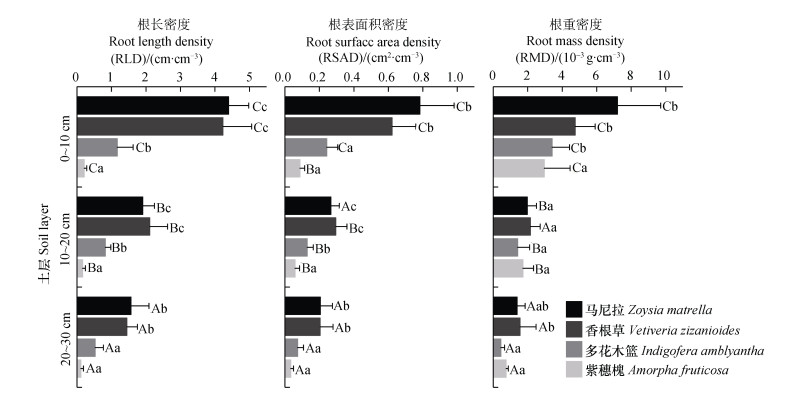
|
注:图中不同大写字母表示不同土层间差异显著;不同小写字母表示同一土层内不同植被类型间差异显著(P < 0.05)。下同 Note:Different capital letters indicate significant between differences soil layers at the level of 0.05;different lowercase letters indicate significant differences between types of the overlying vegetation at the level of 0.05. The same as below 图 1 不同植被类型的根系参数 Fig. 1 Root parameters of different types of vegetation |
在0~0.5 mm和0.5~1 mm径级内,马尼拉和香根草的RLD要显著大于多花木蓝和紫穗槐,不同土层内直径 < 2 mm的细根系占了总根系的绝大部分,在4种植物中占比分别为99.53%~99.81%、98.83%~99.39%、95.56%~98.99%以及86.26%~94.85%,其中直径 < 0.5 mm根系贡献最大,且土层越深,占比越大,此外,马尼拉和香根草在3个土层均未发现直径 > 5 mm的根系。除个别指标外,不同径级RLD在不同土层间均表现出显著差异,且随土壤深度的增加RLD显著降低(图 2)。
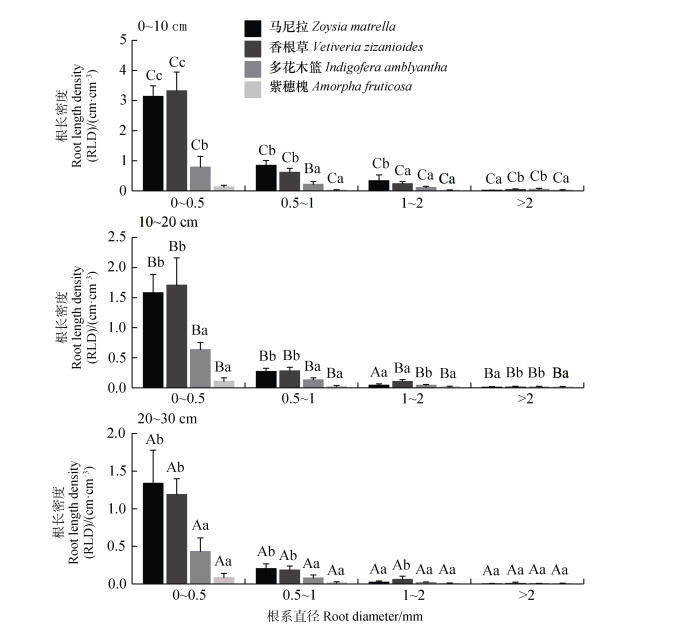
|
图 2 不同径级内的根长密度 Fig. 2 RLD relative to grade of root diameters |
4种植被类型土壤的快速湿润(FW)试验中,3个土层中团聚体含量最高的部分均出现在0.25~0.5 mm,预湿润后扰动(WS)试验均出现在1~2 mm,慢速湿润(SW)试验出现在2~5 mm。同时可以观察到不同植被下不同土层中的土壤团聚体的主要成分均为直径 > 0.25 mm的团聚体,占土壤总重量的50.45%~98.71%(图 3)。
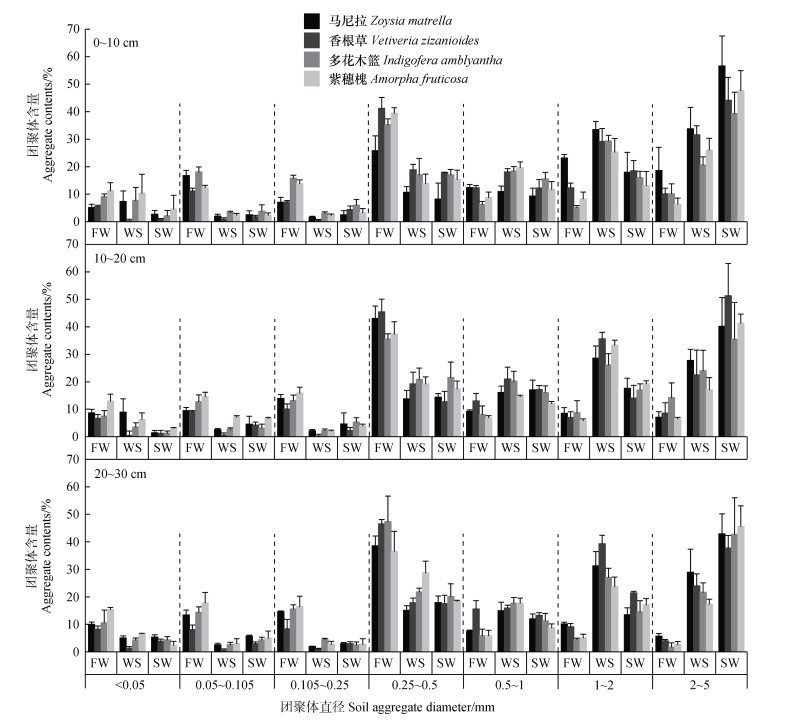
|
注:FW,快速湿润;WS,预湿润后扰动;SW,慢速湿润。 Note:FW, fast wetting; WS, wet stirring; SW, slow wetting. 图 3 不同植被类型下的土壤团聚体分布 Fig. 3 Fraction distribution of soil aggregates relative to type of the overlying vegetation |
3个土层的FW试验中,马尼拉和香根草中 > 0.25 mm团聚体含量均显著高于多花木蓝和紫穗槐,在0~10 cm土层中WS和SW试验也有类似的趋势,但差异不显著。4种植被相比,WS和SW试验中 > 0.25 mm团聚体含量在香根草中均为最高(在0~10 cm土层分别为99.41%和92.63%,在10~20 cm土层分别为98.72%和92.07%,在20~30 cm土层分别为96.9%和90.02%),FW试验中,0~10 cm土层 > 0.25 mm团聚体含量最高的为马尼拉,10~30 cm土层中最高为香根草。马尼拉和紫穗槐在3次试验中 > 0.25 mm团聚体含量均表现为FW < WS < SW,而香根草和多花木蓝表现为FW < SW < WS,FW试验中的 > 0.25 mm团聚体含量均为最低。3次试验的 > 0.25 mm团聚体含量按以下顺序增加:香根草 > 马尼拉 > 多花木蓝 > 紫穗槐。
在FW和WS试验中,马尼拉和香根草在3个土层的MWD均要大于多花木蓝和紫穗槐,且在0~10 cm土层中差异显著。在WS试验中MWD均表现为马尼拉 > 香根草 > 多花木蓝 > 紫穗槐,在FW试验中,0~10 cm土层MWD为马尼拉最高,10~30 cm土层均为香根草最高。在3个土层内,FW试验测得的MWD范围为0.39~1.21 mm,WS为1.21~1.83 mm,SW为1.81~2.36 mm,在同一土层内不同植被下的MWD均表现为FW < WS < SW,并且在所有不同处理中,FW均要显著低于WS和SW,但WS和SW之间差异并不显著(图 4)。
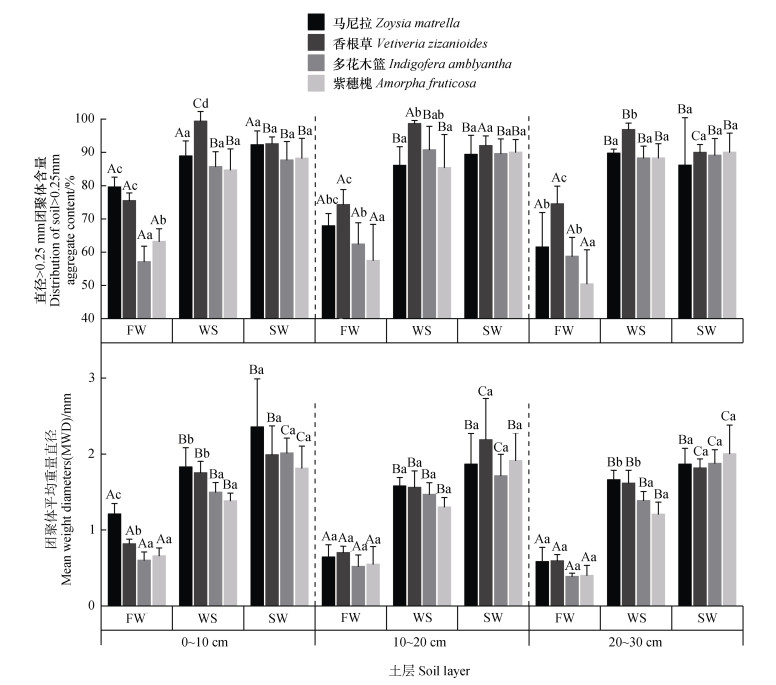
|
注:图中不同的大写字母表示不同处理(FW,快速湿润;WS,预湿润后扰动;SW,慢速湿润)的差异显著(P < 0.05);不同的小写字母表示不同植被类型的差异显著(P < 0.05)。 Note:Different capital letters indicate significant differences between treatments(FW, fast wetting; WS, wet stirring; SW, slow wetting)at the level of 0.05;different lowercase letters indicate significant differences between types of the overlying vegetation types at the level of 0.05. 图 4 不同植被类型下 > 0.25 mm团聚体和MWD分布 Fig. 4 Distributions of > 0.25 mm fraction of soil aggregates size and mean weight diameters(MWD)relative to type of the overlying vegetation |
有机质、RLD、RSAD、RMD以及 < 2 mm RLD与FW试验中 < 0.05 mm和0.105~0.25 mm径级团聚体含量均具有显著(P < 0.05)负相关关系,与FW试验中的1~2 mm和 > 2 mm径级团聚体以及WS试验中的 > 2 mm径级团聚体具有极显著(P < 0.01)正相关关系,此外在SW试验中,0.25~0.5 mm团聚体与上述指标具有显著(P < 0.05)负相关关系,而 > 2 mm RLD与3种试验的团聚体指标均无相关性。总体看来,土壤性质和根系参数与FW试验中的团聚体指标相关性较强,与WS和SW试验的相关性较弱。而黏粒、粉粒以及直径 < 0.5 mm RLD与MWD在3种试验中相关性均不显著,与MWD相关性较高的指标包括有机质、容重、砂粒以及RMD等,从不同径级来看,0.5~1 mm和1~2 mm径级的细根系是影响MWD最为关键的因素(图 5)。
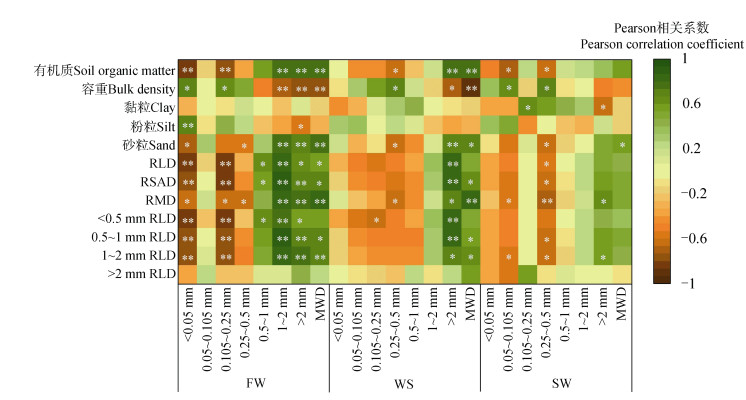
|
注:< 0.5 mm RLD为直径 < 0.5 mm根系的根长密度;0.5~1 mm RLD为直径0.5~1 mm根系的根长密度;1~2 mm RLD为直径1~2 mm根系的根长密度;> 2 mm RLD为直径 > 2 mm根系的根长密度;* P < 0.05;** P < 0.01。下同。Note:< 0.5 mm RLD means root length density of the roots less than 0.5 mm in diameter; 0.5~1 mm RLD, root length density of the roots 0.5~1 mm in diameter; 1~2 mm RLD, root length density of the roots 1~2 mm in diameter; 2 mm RLD, root length density of the roots more than 2 mm in diameter; * P < 0.05;** P < 0.01. The same below. 图 5 团聚体指标与土壤性质、根系参数的相关分析 Fig. 5 Correlation analysis of aggregate index with soil properties and root parameters |
植被恢复是改善土壤质量和防止水土流失的有效途径[17],植被对土壤性质会产生很大的影响,其主要表现在植物根系对土壤结构的挤压、穿插和分割作用,以及死亡根系和枯枝落叶产生的有机质、根际分泌物影响到土壤理化性质[14]。植被的年龄和类型均对土壤结构发育具有显著影响,而植被类型对土壤结构发育的影响更大[11],本研究中土壤质地较黏重,属于粉质黏土,但在不同植被类型下,土壤理化性状具有显著差异,尤其是草本植物与灌木之间的差异,草本植物具有更高的有机质和砂粒含量,以及较低的容重,说明草本植物根系对于改善土壤黏重质地的作用要强于灌木,这与前人关于黄土高原植被恢复[8, 11]的研究结果一致。
土壤团聚体状况是影响土壤肥力的重要因素,其在很大程度上影响到土壤通气性与抗蚀性,而 > 0.25 mm团聚体是提升土壤抗侵蚀能力的关键[18]。本研究中马尼拉和香根草覆盖下 > 0.25 mm团聚体含量均要明显高于多花木蓝和紫穗槐,尤其是在FW和WS处理中,草本植物的大团聚体比例要更高。根据Amézketa等[19]研究,在LB法的FW和WS试验中,MWD等团聚体稳定性指标与侵蚀量、侵蚀率、入渗率和溅蚀率等土壤侵蚀指标显著相关,闫峰陵等[20]针对红壤的研究也指出湿筛法中的MWD与侵蚀量和径流强度相关程度最高,因此使用MWD来表征团聚体稳定性是可行的,本研究在MWD方面表现为马尼拉 > 香根草 > 多花木蓝 > 紫穗槐,这意味着草本植物覆盖土壤结构更坚固,抗蚀性更强。综上所述,草本植物在改良土壤孔隙状况和团聚体稳定性等方面较灌木更有效。
3.2 土壤性质及根系性状对团聚体的影响有机质含量和FW、WS中的MWD具有极显著正相关关系,有研究[21]指出植被恢复过程中土壤团聚体有机碳含量主要集中在大团聚体中,而较高的有机质含量和碳水化合物含量能通过黏土颗粒之间的桥联作用促进团聚体的形成和稳定[22],Chenu等[23]认为有机质是通过降低团聚体的润湿性和增强团聚体的凝聚力来提高团聚体的稳定性。而容重与FW、WS中的MWD具有极显著负相关关系,Udawatta等[24]将树木和草本覆盖之间的土壤容重差异归因于根系活动的差异和有机物质,有机质增加土壤生物活性,从而进一步促进孔隙发育,从而影响到团聚体的形成[8]。此外,本研究砂粒含量与MWD有显著正相关,而黏粒和粉粒相关性不强,这是由于本研究中砂粒含量与土壤孔隙度呈相同变化趋势,砂粒含量高的土壤孔隙度大,增强了土壤的透水、通气性,水热养分条件一致时更有利于植物根系发育,这与高传友等[25]、王雅琼等[26]的研究结果相似。不同植被类型下的砂粒含量的差异可能与土壤细颗粒物质的流失有关,而植被恢复过程中地上部分对地表径流的截留作用具有明显差异,其具体机制还需今后进一步分析。
根据相关性分析,在FW和WS中,RLD、RSAD和RMD等根系参数与MWD和 > 2 mm的大颗粒团聚体含量均具有极显著正相关性,其中直径0.5~2 mm细根系是影响MWD的关键因素,而土壤性质与团聚体稳定性的相关性要低于根系特征,植物根系是间接影响土壤团聚体稳定性的主要因素,与已有相关研究[27-28]结果一致。根系不仅能通过穿插作用来疏松土壤,而且可通过生物和化学作用来改善土壤结构[29],其中细根对土壤团聚体的增强是通过与菌根和真菌的相互作用,产生渗出物和结合剂,促进土壤团聚体的形成[28],有研究表明根长与菌丝化程度之间的相关系数高达0.86[30],同时真菌丰度对团聚体稳定性也有显著的正向影响,此外菌根可能影响MWD,同时影响寄主植物的根系性状[10]。此外细根的生理活性强,具有较高的生长速率和死亡分解率,活根分泌有机酸,死根提供有机质,二者作为土粒团聚体的胶结剂,配合须根的穿插和缠结,促进土壤中大团聚体的形成,从而增强土壤抗分散、抗悬浮的能力[31]。本研究中草本植物的细根系含量均要显著高于灌木,因而具有更强的团聚体稳定性。
3.3 不同破坏机制下土壤团聚体的差异LB法使用的3种试验方法是根据团聚体的不同破坏机制制定,其中FW是模拟夏季暴雨条件下的团聚体破裂机制,强调的是湿润破坏机制的消散作用;WS模拟的是雨滴的打击破坏作用,强调的是机械破坏;SW对应于温和降雨下的田间湿润条件,体现的是土壤黏粒膨胀作用[15],而消散和机械外力是降雨条件下团聚体的两种主要破坏机制[32]。本研究在同一植被类型下,FW试验中的MWD要显著低于其他试验,根据Le Bissonnais的分类[15]对MWD划分等级,本研究使用WS和SW方法测得的MWD介于1.21~2.36 mm,均相当于稳定的土壤团聚体,FW测得MWD介于0.39~1.21 mm,属于不稳定团聚体,且3种试验之后均以直径 > 0.25 mm团聚体为主,总体表现为WS占比最大,SW次之,FW最小。同时FW中的团聚体指标与土壤性质、根系参数等相关性要明显强于SW和WS,说明暴雨是破坏研究区内土壤团聚体的最主要因素,而雨滴击打和慢速湿润的破坏作用不大,由于暴雨中也有水分润湿的作用存在,FW试验对团聚体稳定性的破坏作用实际也包含了SW的贡献,同时WS强调的雨滴击溅力实际上是比较弱的[33],因此FW试验是评价区域内土壤团聚体能力的一种较好方法,这与已有相关研究结论一致[9, 19],也有研究[34]指出SW试验适用于评价黄土高原草地植被带的团聚体稳定性,说明在选择评价土壤团聚体稳定性的方法时,需考虑不同土壤和土地利用类型的差异。
4 结论植被恢复是提高南方红壤区内土壤质量和团聚体稳定性的有效措施,草本(马尼拉、香根草)覆盖下的土壤有机质含量、砂粒含量和孔隙度要高于灌木(多花木蓝、紫穗槐),且具有更高的土壤团聚体稳定性,说明草本植物改良土壤结构的作用要优于灌木,这主要是由于草本植物具有更为发达的根系,其中0.5~2 mm径级细根系的作用最为关键。使用LB法测定了在不同破坏机制下的团聚体稳定性,研究区内不同植被下土壤团聚体的最主要破坏机制均为消散作用,同时由于区域内夏季暴雨较频繁,而FW能较全面地模拟自然条件下土壤团聚体的破坏机制,是评价区域内土壤团聚体稳定性的较优方法。
| [1] |
刘国华, 傅伯杰, 陈利顶, 等. 中国生态退化的主要类型、特征及分布. 生态学报, 2000, 20(1): 13-19. Liu G H, Fu B J, Chen L D, et al. Characteristics and distributions of degraded ecological types in China (In Chinese). Acta Ecologica Sinica, 2000, 20(1): 13-19. (  0) 0) |
| [2] |
Stokes A, Sotir R, Chen W, et al. Soil bio-and eco-engineering in China: Past experience and future priorities . Ecological Engineering, 2010, 36(3): 247-257.
(  0) 0) |
| [3] |
郝好鑫, 郭忠录, 王先舟, 等. 降雨和径流条件下红壤坡面细沟侵蚀过程. 农业工程学报, 2017, 33(8): 134-140. Hao H X, Guo Z L, Wang X Z, et al. Rill erosion process on red soil slope under interaction of rainfall and scouring flow (In Chinese). Transactions of the Chinese Society of Agricultural Engineering, 2017, 33(8): 134-140. (  0) 0) |
| [4] |
Kutílek M. Slope stabilization and erosion control: A bioengineering approach . Soil Technology, 1995, 8(1): 75-76.
(  0) 0) |
| [5] |
Cheng M, Xiang Y, Xue Z J, et al. Soil aggregation and intra-aggregate carbon fractions in relation to vegetation succession on the Loess Plateau, China . Catena, 2015, 124(1): 77-84.
(  0) 0) |
| [6] |
Barthès B, Roose E. Aggregate stability as an indicator of soil susceptibility to runoff and erosion, validation at several levels . Catena, 2002, 47(2): 133-149.
(  0) 0) |
| [7] |
Cerdà A. Soil aggregate stability under different Mediterranean vegetation types . Catena, 1998, 32(2): 73-86.
(  0) 0) |
| [8] |
Zhao D, Xu M X, Liu G B, et al. Effect of vegetation type on microstructure of soil aggregates on the Loess Plateau, China . Agriculture, Ecosystems & Environment, 2017, 242: 1-8.
(  0) 0) |
| [9] |
Zeng Q C, Darboux F, Man C, et al. Soil aggregate stability under different rain conditions for three vegetation types on the Loess Plateau(China) . Catena, 2018, 167: 276-283.
(  0) 0) |
| [10] |
Demenois J, Rey F, Ibanez T, et al. Linkages between root traits, soil fungi and aggregate stability in tropical plant communities along a successional vegetation gradient . Plant and Soil, 2018, 424(1/2): 319-334.
(  0) 0) |
| [11] |
Caravaca F, Lax A, Albaladejo J. Aggregate stability and carbon characteristics of particle-size fractions in cultivated and forested soils of semiarid Spain . Soil and Tillage Research, 2004, 78(1): 83-90.
(  0) 0) |
| [12] |
An S S, Darboux F, Cheng M. Revegetation as an efficient means of increasing soil aggregate stability on the Loess Plateau(China) . Geoderma, 2013, 209/210: 75-85.
(  0) 0) |
| [13] |
Pérès G, Cluzeau D, Menasseri S, et al. Mechanisms linking plant community properties to soil aggregate stability in an experimental grassland plant diversity gradient . Plant and Soil, 2013, 373(1/2): 285-299.
(  0) 0) |
| [14] |
刘雷, 安韶山, 黄华伟. 应用Le Bissonnais法研究黄土丘陵区植被类型对土壤团聚体稳定性的影响. 生态学报, 2013, 33(20): 6670-6680. Liu L, An S S, Huang H W. Application of le bissonnais method to study soil aggregate stability under different vegetaion on the loess plateau (In Chinese). Acta Ecologica Sinica, 2013, 33(20): 6670-6680. (  0) 0) |
| [15] |
Bissonnais Y. Aggregate stability and assessment of soil crustability and erodibility: Ⅰ. Theory and methodology . European Journal of Soil Science, 1996, 47(4): 425-437.
(  0) 0) |
| [16] |
Fattet M, Fu Y, Ghestem M, et al. Effects of vegetation type on soil resistance to erosion: Relationship between aggregate stability and shear strength . Catena, 2011, 87(1): 60-69.
(  0) 0) |
| [17] |
赵冬, 许明祥, 刘国彬, 等. 用显微CT研究不同植被恢复模式的土壤团聚体微结构特征. 农业工程学报, 2016, 32(9): 123-129. Zhao D, Xu M X, Liu G B, et al. Characterization of soil aggregate microstructure under different revegetation types using micro-computed tomography (In Chinese). Transactions of the Chinese Society of Agricultural Engineering, 2016, 32(9): 123-129. (  0) 0) |
| [18] |
Amézketa E. Soil aggregate stability: A review . Journal of Sustainable Agriculture, 1999, 14(2/3): 83-151.
(  0) 0) |
| [19] |
Amézketa E, Singer M J, Le Bissonnais Y. Testing a new procedure for measuring water-stable aggregation . Soil Science Society of America Journal, 1996, 60(3): 888-894.
(  0) 0) |
| [20] |
闫峰陵, 史志华, 蔡崇法, 等. 红壤表土团聚体稳定性对坡面侵蚀的影响. 土壤学报, 2007, 44(4): 577-583. Yan F L, Shi Z H, Cai C F, et al. Effects of topsoil aggregate stability on soil erosion at hillslope on ultisoils (In Chinese). Acta Pedologica Sinica, 2007, 44(4): 577-583. (  0) 0) |
| [21] |
赵世伟, 苏静, 吴金水, 等. 子午岭植被恢复过程中土壤团聚体有机碳含量的变化. 水土保持学报, 2006, 20(3): 114-117. Zhao S W, Su J, Wu J S, et al. Changes of soil aggregate organic carbon during process of vegetation restoration in Ziwuling (In Chinese). Journal of Soil and Water Conservation, 2006, 20(3): 114-117. (  0) 0) |
| [22] |
Chaplot V, Cooper M. Soil aggregate stability to predict organic carbon outputs from soils . Geoderma, 2015, 243/244: 205-213.
(  0) 0) |
| [23] |
Chenu C, Le Bissonnais Y, Arrouays D. Organic matter influence on clay wettability and soil aggregate stability . Soil Science Society of America Journal, 2000, 64(4): 1479-1486.
(  0) 0) |
| [24] |
Udawatta R P, Anderson S H, Gantzer C J, et al. Agroforestry and grass buffer influence on macropore characteristics . Soil Science Society of America Journal, 2006, 70(5): 1763-1773.
(  0) 0) |
| [25] |
高传友, 赵清贺, 刘倩. 北江干流河岸带不同植被类型土壤粒径分形特征. 水土保持研究, 2016, 23(3): 37-42. Gao C Y, Zhao Q H, Liu Q. Fractal characteristic of soil particle size under different vegetation types in riparian zone of the main stream of Beijiang river (In Chinese). Research of Soil and Water Conservation, 2016, 23(3): 37-42. (  0) 0) |
| [26] |
王雅琼, 张建军, 李梁, 等. 祁连山区典型草地生态系统土壤抗冲性影响因子. 生态学报, 2018, 38(1): 122-131. Wang Y Q, Zhang J J, Li L, et al. Analysis of factors impacting soil anti-scourability of typical grassland ecosystems on the Qilian Mountains (In Chinese). Acta Ecologica Sinica, 2018, 38(1): 122-131. (  0) 0) |
| [27] |
Gyssels G, Poesen J, Bochet E, et al. Impact of plant roots on the resistance of soils to erosion by water: A review . Progress in Physical Geography: Earth and Environment, 2005, 29(2): 189-217.
(  0) 0) |
| [28] |
葛芳红, 周正朝, 刘俊娥, 等. 黄土丘陵区4种典型植物根系分布特征及对土壤分离速率的影响. 水土保持学报, 2017, 31(6): 164-169. Ge F H, Zhou Z C, Liu J E, et al. Distribution characteristics of root and their effect on soil separation rate of four typical plants in loess hilly region (In Chinese). Journal of Soil and Water Conservation, 2017, 31(6): 164-169. (  0) 0) |
| [29] |
Eisenhauer N, Milcu A, Sabais A C W, et al. Plant diversity surpasses plant functional groups and plant productivity as driver of soil biota in the long term[J]. PLoS One, 2011, 6(1): e16055. https: //doi.org/10.1371/ journal.pone.0016055.
(  0) 0) |
| [30] |
Graf F, Frei M. Soil aggregate stability related to soil density, root length, and mycorrhiza using site-specific Alnus incana and Melanogaster variegatus s.l . Ecological Engineering, 2013, 57(8): 314-323.
(  0) 0) |
| [31] |
熊燕梅, 夏汉平, 李志安, 等. 植物根系固坡抗蚀的效应与机理研究进展. 应用生态学报, 2007, 18(4): 895-904. Xiong Y M, Xia H P, Li Z A, et al. Effects and mechanisms of plant roots on slope reinforcement and soil erosion resistance: A research review (In Chinese). Chinese Journal of Applied Ecology, 2007, 18(4): 895-904. (  0) 0) |
| [32] |
肖海, 刘刚, 赵金凡, 等. 雨滴机械打击和消散作用对土壤团聚体的破坏特征. 土壤学报, 2017, 54(4): 827-835. Xiao H, Liu G, Zhao J F, et al. Characteristics of mechanical impact and slaking effect of rain drops on soil aggregates (In Chinese). Acta Pedologica Sinica, 2017, 54(4): 827-835. (  0) 0) |
| [33] |
Nearing M A, Bradford J M, Holtz R D. Measurement of force vs. time relations for waterdrop impact . Soil Science Society of America Journal, 1986, 50(6): 1532-1536.
(  0) 0) |
| [34] |
曾全超, 李娅芸, 刘雷, 等. 黄土高原草地植被土壤团聚体特征与可蚀性分析. 草地学报, 2014, 22(4): 743-749. Zeng Q C, Li Y Y, Liu L, et al. Study on soil aggregate stability and soil erodibility in the grassland vegetation of the loess plateau region (In Chinese). Acta Agrestia Sinica, 2014, 22(4): 743-749. (  0) 0) |
2. Jiangxi Institute of Soil and Water Conservation, Nanchang 330029, China
 2020, Vol. 57
2020, Vol. 57


